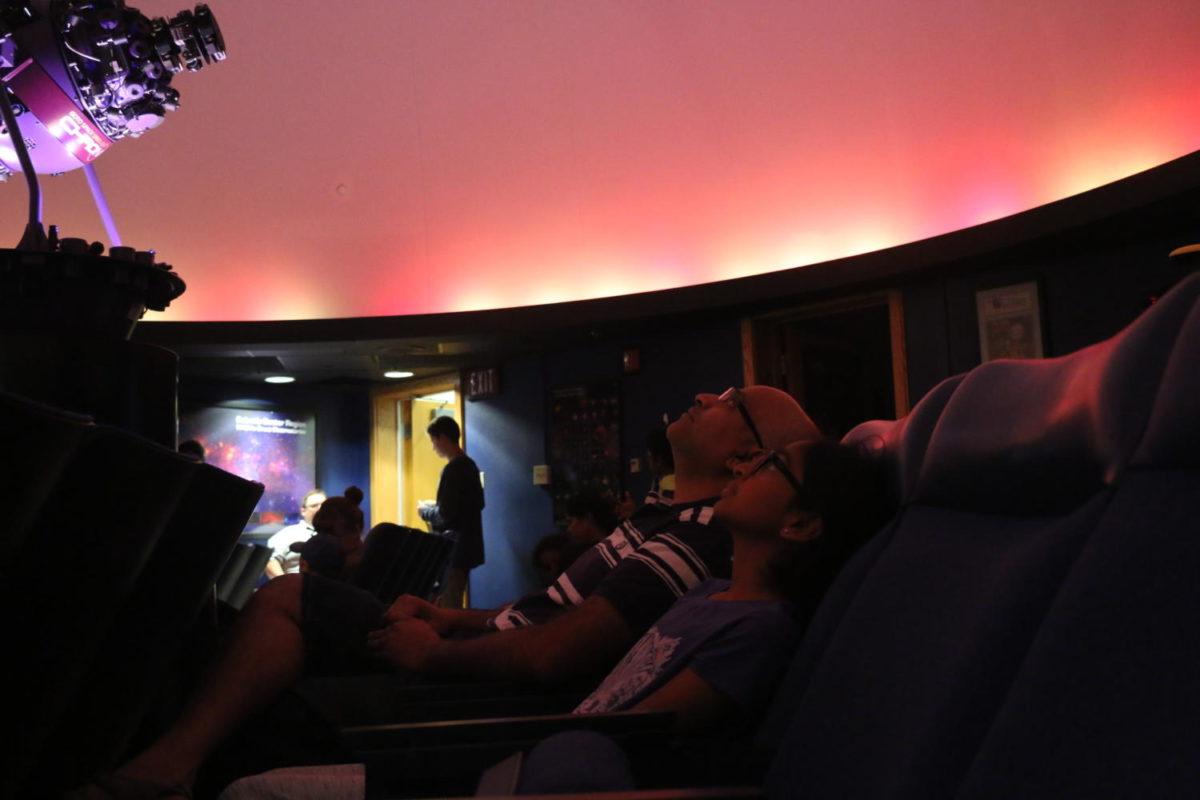Astronomy teacher Keith Turner and students held a planetarium show at the CHS planetarium on Sept. 28. Doors opened to the public at 7 p.m. and the show began at 7:30 p.m. with tickets selling for $4 for adults and $2 for children, seniors, and CHS students.
According to Turner, preparations leading up to the show include planning and organizing in order to construct the program, followed by advertising the show.
Andrew Sleugh, astronomy club leader and junior, said that preparation for shows is usually easy.
“Sometimes there’s video editing we do for it and then other times we just sort of like splice it between the different screens. Most of the time it’s pretty easy preparation,” Sleugh said.
The planetarium show began with a view of the sky in the morning, then gradually moved to show the sky later in the day, around 8:30 p.m.. Turner explained to the audience how astronomers are able to tell that autumn has started by the movement of the sun as it crosses the equator. Turner pointed out different planets and constellations in the sky and identified them to the audience. Members of the audience were able to observe what the sky would look like at night without the light pollution from humans. This was a view of hundreds of bright stars against a pitch black sky. Lastly, Turner showed actual photos he took at the solar eclipse in August and explained to the audience his experience as well as the facts behind the solar eclipse.
After the show, telescopes were set up in front of the school for audience members to use. Through these telescopes, people were able to observe the stars, constellations, and planets through a clearer lense.
From the planetarium show, audience members were able to learn how to identify the different stars and constellations in the sky. People were also able to learn more about the astronomical transition from summer to autumn and the facts and appearance of a total solar eclipse.

































![AI in films like "The Brutalist" is convenient, but shouldn’t take priority [opinion]](https://hilite.org/wp-content/uploads/2025/02/catherine-cover-1200x471.jpg)









































![Review: “The Immortal Soul Salvage Yard:” A criminally underrated poetry collection [MUSE]](https://hilite.org/wp-content/uploads/2025/03/71cju6TvqmL._AC_UF10001000_QL80_.jpg)
![Review: "Dog Man" is Unapologetically Chaotic [MUSE]](https://hilite.org/wp-content/uploads/2025/03/dogman-1200x700.jpg)
![Review: "Ne Zha 2": The WeChat family reunion I didn’t know I needed [MUSE]](https://hilite.org/wp-content/uploads/2025/03/unnamed-4.png)
![Review in Print: Maripaz Villar brings a delightfully unique style to the world of WEBTOON [MUSE]](https://hilite.org/wp-content/uploads/2023/12/maripazcover-1200x960.jpg)
![Review: “The Sword of Kaigen” is a masterpiece [MUSE]](https://hilite.org/wp-content/uploads/2023/11/Screenshot-2023-11-26-201051.png)
![Review: Gateron Oil Kings, great linear switches, okay price [MUSE]](https://hilite.org/wp-content/uploads/2023/11/Screenshot-2023-11-26-200553.png)
![Review: “A Haunting in Venice” is a significant improvement from other Agatha Christie adaptations [MUSE]](https://hilite.org/wp-content/uploads/2023/11/e7ee2938a6d422669771bce6d8088521.jpg)
![Review: A Thanksgiving story from elementary school, still just as interesting [MUSE]](https://hilite.org/wp-content/uploads/2023/11/Screenshot-2023-11-26-195514-987x1200.png)
![Review: "When I Fly Towards You", cute, uplifting youth drama [MUSE]](https://hilite.org/wp-content/uploads/2023/09/When-I-Fly-Towards-You-Chinese-drama.png)
![Postcards from Muse: Hawaii Travel Diary [MUSE]](https://hilite.org/wp-content/uploads/2023/09/My-project-1-1200x1200.jpg)
![Review: "Ladybug & Cat Noir: The Movie," departure from original show [MUSE]](https://hilite.org/wp-content/uploads/2023/09/Ladybug__Cat_Noir_-_The_Movie_poster.jpg)
![Review in Print: "Hidden Love" is the cute, uplifting drama everyone needs [MUSE]](https://hilite.org/wp-content/uploads/2023/09/hiddenlovecover-e1693597208225-1030x1200.png)
![Review in Print: "Heartstopper" is the heartwarming queer romance we all need [MUSE]](https://hilite.org/wp-content/uploads/2023/08/museheartstoppercover-1200x654.png)




